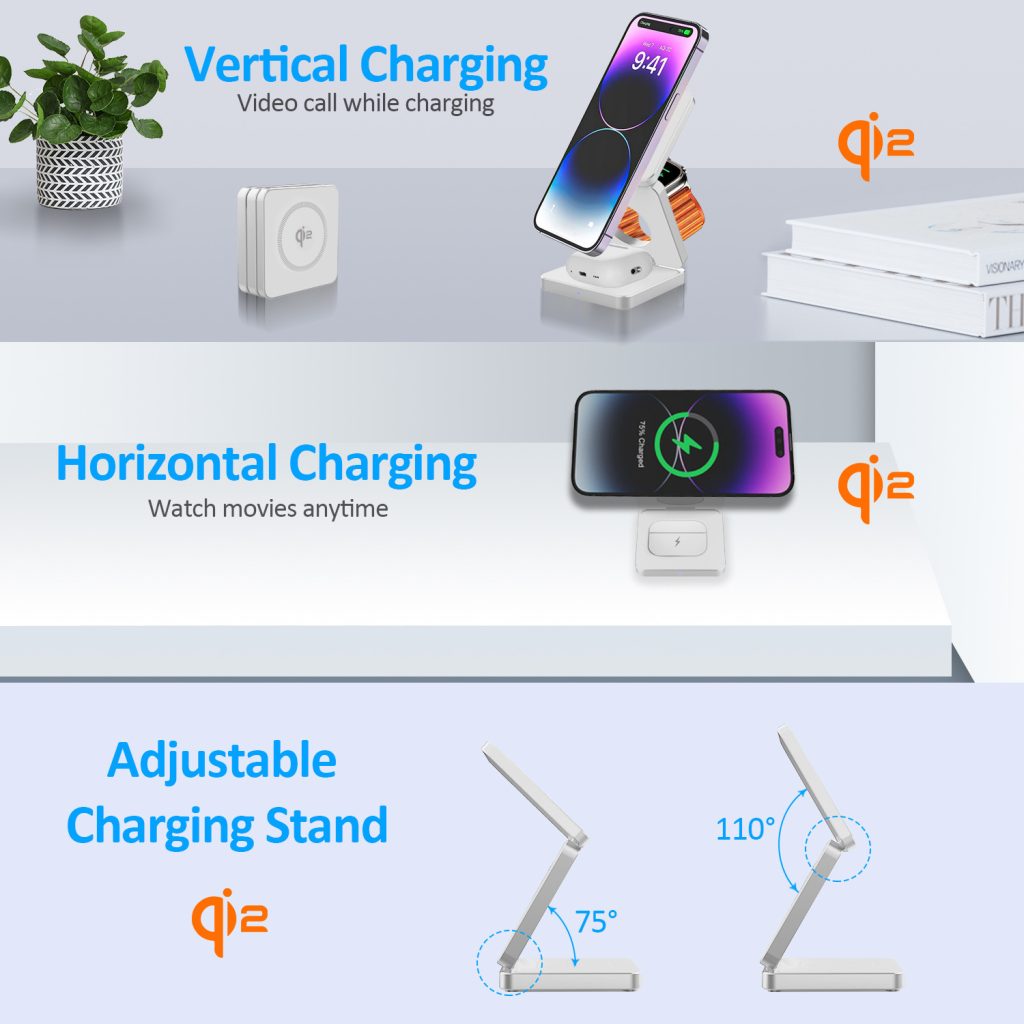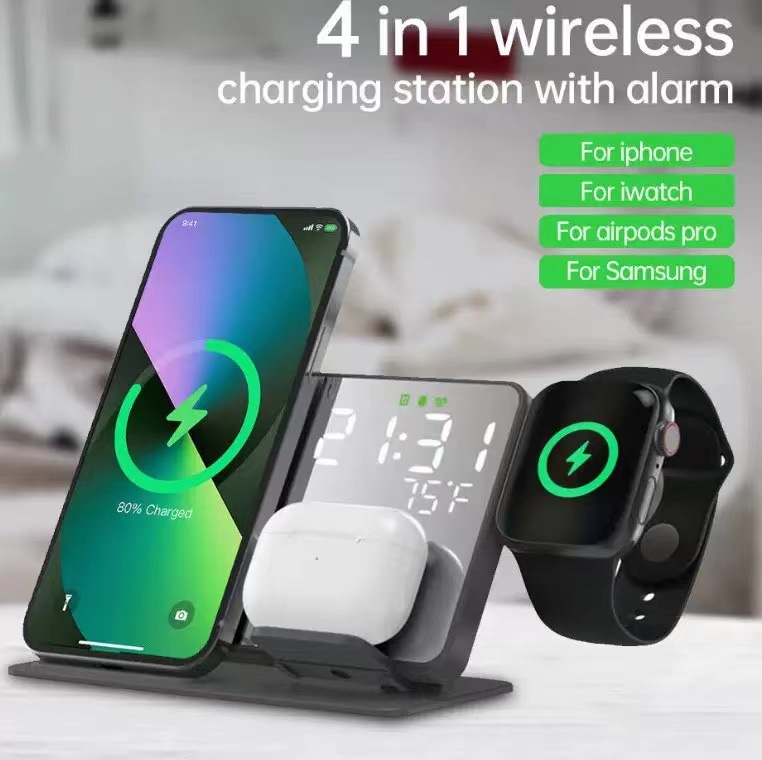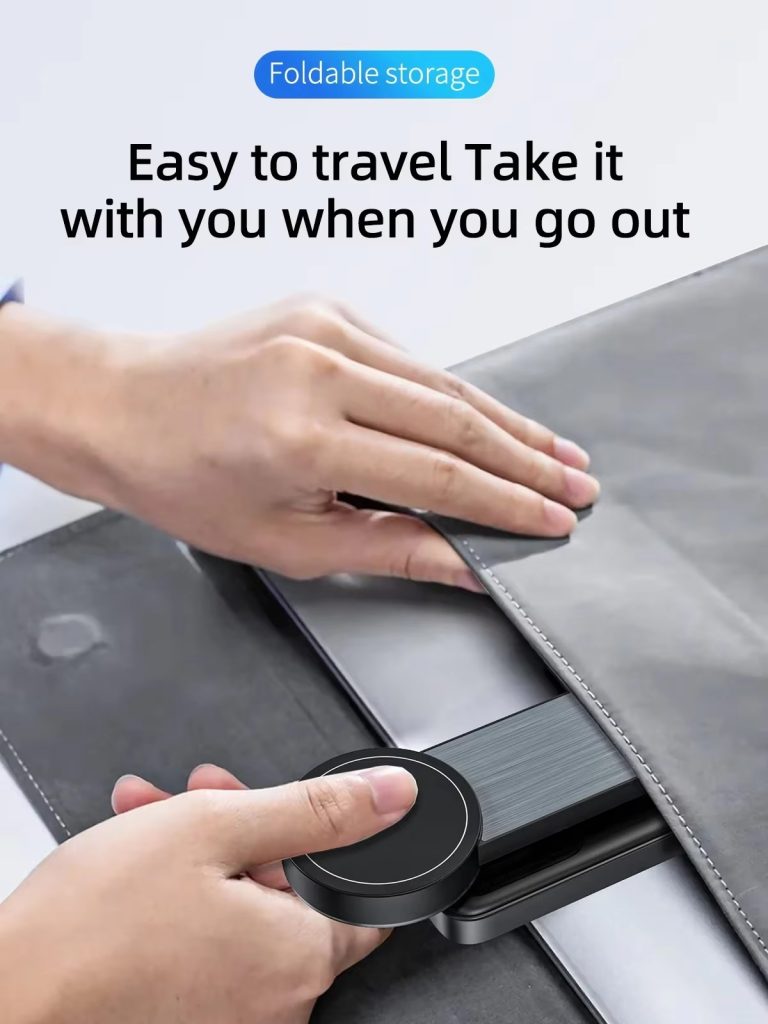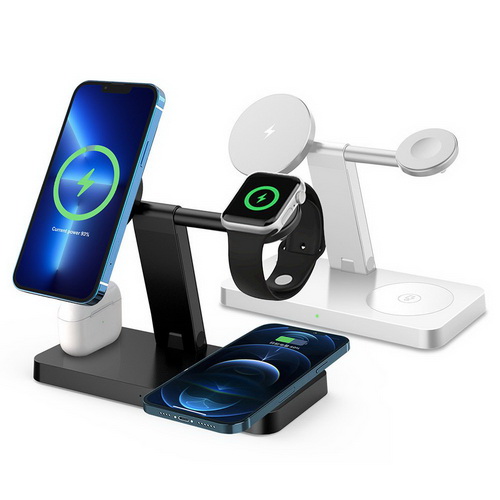3in1 Mobile Phone Wireless Charger: Technical Analysis, Application Scenarios and Future Trends
I. Introduction
Background
In today’s digital age, wireless charging technology is becoming more popular at an unprecedented rate, and the market demand for it is also showing a trend of continuous growth. Behind this trend is the rapid development of science and technology and consumers’ unremitting pursuit of convenient life.
The birth of wireless charging technology has made it possible for people to get rid of the constraints of traditional charging cables. It eliminates the cumbersome operation of plugging and unplugging charging cables, making the charging process easier and more comfortable. From being used only on a few high-end devices in the early days to being supported by many smart phones, wireless headphones, smart watches and other products today, wireless charging has gradually entered thousands of households.
With the advancement of technology, the number of electronic devices people own is increasing. Many users not only have mobile phones, but also have devices such as wireless headphones and smart watches. These devices play an important role in daily life and work, but also bring charging troubles. Multi-device users need to equip each device with a corresponding charger and charging cable, which not only leads to a messy desktop, but also makes it inconvenient to carry multiple chargers when traveling or working. Therefore, their demand for efficient charging solutions is becoming increasingly urgent.
Technology giants such as Apple and Samsung have played an important role in promoting the wireless charging ecosystem. Take Apple as an example. Its iPhone series of mobile phones have supported wireless charging since iPhone 8, and then launched AirPods wireless headphones and Apple Watch smart watches, forming a complete wireless charging ecosystem. Samsung also widely uses wireless charging technology in its flagship mobile phones and wearable devices, further promoting the development of the wireless charging market. The demonstration effect of these brands has enabled more consumers to accept and use wireless charging devices, driving the growth of market demand.
Definition of 3-in-1 wireless charger

3in1 Mobile Phone Wireless Charger is an integrated device that supports charging of mobile phones, wireless headphones, and smart watches at the same time. It appeared to meet the needs of multi-device users for efficient charging and solve the cable confusion and inconvenience caused by traditional charging methods.
The core value of this charger is to reduce cable confusion and improve charging convenience. Users only need to place their mobile phones, wireless headphones, and smart watches in the corresponding areas of the charger to charge these three devices at the same time without frequently plugging and unplugging the charging cable. This not only saves time and energy, but also makes the desktop more tidy and orderly. Whether at home, in the office or on the go, the 3-in-1 wireless charger can provide users with a convenient charging experience.
2. Technical analysis: The working principle of the 3-in-1 wireless charger
Basics of wireless charging technology
At present, the 3-in-1 wireless charger mainly uses the principle of electromagnetic induction for charging, among which the Qi standard is the main one. The Qi standard is a global wireless charging standard developed by the Wireless Power Consortium (WPC), which ensures interoperability between devices of different brands and models.
The principle of electromagnetic induction is based on Faraday’s law of electromagnetic induction. When current passes through a coil, an alternating magnetic field is generated. If another coil is placed within this magnetic field, according to the law of electromagnetic induction, an induced current will be generated in the second coil, thereby realizing the transmission of electrical energy. In a wireless charger, the transmitting coil is located inside the charger, and the receiving coil is integrated in the charged device. When the charged device is close to the charger, the alternating magnetic field generated by the transmitting coil will induce a current in the receiving coil, thereby charging the device.
The charging efficiency of a 3-in-1 wireless charger is usually in the power range of 5W – 15W, and the adaptability of different devices to the charging power is also different. For example, some early wireless charging devices may only support 5W charging power, while newer devices can support higher power, such as 7.5W, 10W or even 15W. Taking the iPhone as an example, iPhone phones that support the Qi standard can achieve fast wireless charging when using a charger that supports 7.5W or 15W. Devices such as AirPods and Galaxy Watch also have their own adapted charging power.

Implementation of 3-in-1 design
In order to realize the function of charging mobile phones, wireless headphones and smart watches at the same time, the 3-in-1 wireless charger adopts a multi-coil layout design. Inside the charger, independent coils are allocated for different charging areas. For example, there is a dedicated coil in the mobile phone charging area, another coil in the wireless headset charging area, and a corresponding coil in the smart watch charging area. These independent coils can provide the power required for charging different devices respectively without interfering with each other.
Intelligent power distribution is another important feature of the 3-in-1 wireless charger. Since different devices have different power requirements when charging, the charger will automatically adjust the output power of each coil according to the power status and charging requirements of the device, and give priority to powering devices with high power requirements. For example, when the phone needs to be charged quickly due to low battery, the charger will allocate more power to the phone charging area, while less power will be allocated to wireless headphones and smart watches with relatively high battery. Belkin 3-in-1 charging pad is a typical example, which supports fast charging of mobile phones and can provide stable charging for headphones and watches. When the phone is placed on the charging pad, if the phone supports fast charging, the charging pad will automatically identify and provide corresponding high-power charging; while the headphones and watches will be charged at a stable power to ensure that each device can get reasonable charging support.
Compatibility and safety
The 3-in-1 wireless charger needs to have good device compatibility to meet the charging needs of devices of different brands and models. It must not only support Apple MagSafe devices, but also be compatible with non-MagSafe devices. Apple MagSafe is a magnetic wireless charging technology launched by Apple, which has stronger adsorption force and more efficient charging performance. For non-MagSafe devices, such as most Android phones, wireless headphones and smart watches, the charger also needs to be able to provide stable charging support.
In order to ensure the safety and reliability of the charging process, the 3-in-1 wireless charger is equipped with a variety of safety protection mechanisms. Overvoltage protection is one of the important protection measures. It can prevent the charger from outputting too high a voltage and avoid damaging the charged device. When the charger detects that the output voltage exceeds the safe range, it will automatically adjust the output voltage to ensure the safety of the device. Temperature control is also essential. A certain amount of heat will be generated during wireless charging. If the temperature is too high, it will not only affect the charging efficiency, but may also cause damage to the device. Therefore, the charger will monitor the temperature in real time and control the temperature through heat dissipation design or automatic power adjustment. The foreign object detection function can prevent the charger from charging in the presence of foreign objects, avoiding safety accidents caused by heat generated by foreign objects or short circuits. When the charger detects foreign objects in the charging area, it will automatically stop charging and send a prompt signal.
3. Advantages and limitations of 3in1 Mobile Phone Wireless Charger
Core advantages
Convenience
One of the biggest advantages of 3-in-1 wireless chargers is its convenience. Compared with traditional wired chargers, users do not need to frequently plug and unplug charging cables. They only need to gently place their mobile phones, wireless headphones and smart watches on the charger to start charging. This place-and-charge method greatly saves time and energy, especially in busy life and work, users can charge their devices more easily. For example, when users return home, they only need to place their mobile phones, headphones and watches on the charger and go to do other things without having to worry about finding charging cables and plugging and unplugging charging heads. Before going to bed at night, users can also place these devices on the charger. When they wake up the next morning, the devices are fully charged and ready to use.
Space optimization
The integrated design allows the 3-in-1 wireless charger to effectively reduce the clutter on the desktop. The traditional charging method requires a separate charger and charging cable for each device. These cables are entangled with each other, which not only affects the appearance, but also easily causes safety hazards. The 3-in-1 wireless charger integrates multiple charging functions into one device. Only one charger is needed to charge three devices at the same time, which greatly reduces the number of cables on the desktop and makes the desktop more tidy and orderly. Whether it is a bedside table at home, a desktop in the office or a room in a hotel, using a 3-in-1 wireless charger can make the space more refreshing.
Scene Adaptation
The 3-in-1 wireless charger has a wide range of scene applicability, and can play its advantages in scenes such as home, office or travel.
In the home scene, it can become a home charging center. On the bedside table, users can charge their mobile phones, watches, and headphones at night for easy use the next day. In the living room, it can also take into account the charging needs of entertainment devices such as mobile phones and game controllers. Users can put their devices on the charger to charge at any time while watching TV or playing games, without worrying about insufficient power.
In the office scene, the 3-in-1 wireless charger can meet the needs of a neat desktop, reduce the interference of cables on the work area, and improve work efficiency. At the same time, it can realize the coordinated charging of multiple devices such as mobile phones, headphones, and smart watches, so that users do not need to pay attention to the power of the device frequently during work, and keep the device available at any time.
In travel and travel scenes, the portability advantage of the 3-in-1 wireless charger is more obvious. Its lightweight design allows users to carry it easily, and it can support charging of multiple devices, reducing the number of chargers carried. For example, Anker’s 3-in-1 charging pad is very suitable for business travelers. When they are on business trips or traveling, they only need to carry one charger to charge their mobile phones, headphones and watches, which is convenient and fast.
Limitation Analysis
Charging Speed
Although 3-in-1 wireless chargers provide a convenient charging method, they are usually slower than wired fast charging in terms of charging speed, especially when charging multiple devices at the same time. After years of development, wired fast charging technology has been able to achieve very high charging power. For example, some mobile phones support 65W or even 100W or more wired fast charging, which can charge the mobile phone from low power to full power in a short time. The charging power of 3-in-1 wireless chargers is usually between 5W and 15W. Even devices that support fast charging will be slower than wired fast charging when charging wirelessly. When multiple devices are charged on the charger at the same time, due to the limited total power of the charger, the power allocated to each device will be further reduced, resulting in a slower charging speed.
Device placement restrictions
3-in-1 wireless chargers have certain requirements for the placement of devices. The device needs to be accurately aligned with the charging area to charge normally. This is because wireless charging is achieved through electromagnetic induction, and efficient power transmission can only be achieved when the receiving coil is accurately aligned with the transmitting coil. If the device is not placed accurately, it may result in reduced charging efficiency or even failure to charge. Compared with wired charging, this placement restriction reduces charging flexibility. Users need to spend some time adjusting the position when placing the device to ensure that the device can charge normally.
Higher cost
Compared with a single charger, the price of a 3-in-1 wireless charger is usually doubled. This is mainly because it integrates multiple charging functions, uses more complex designs and technologies, and requires more R&D and production costs. For example, Apple’s MagSafe three-in-one charger is expensive and only adapts to its own ecosystem, which is costly for some consumers to purchase. In addition, due to its high technical content, the cost of repairing and replacing parts is relatively high.
IV. Application scenarios and user demand analysis
Home scenarios
Bedside table charging
In home scenarios, bedside tables are common places for people to place devices such as mobile phones, watches and headphones. 3-in-1 wireless chargers can be an ideal choice for charging at night. Before going to bed, users only need to place their mobile phones, watches and headphones on the charger and they can sleep peacefully. When you wake up the next morning, these devices are fully charged and ready to use. This centralized charging method is not only convenient and fast, but also avoids affecting sleep at night due to looking for charging cables. At the same time, the integrated design of the charger does not take up too much bedside table space, keeping the desktop tidy.
Living room use
The living room is the main place for family entertainment, and people usually use mobile phones, game controllers and other devices in the living room. The 3-in-1 wireless charger can take into account the charging needs of these entertainment devices. When users watch TV and play games in the living room, they can put the device on the charger to charge at any time without worrying about insufficient power. For example, when users are playing games, if the battery of the mobile phone is low, just put the mobile phone on the charger and continue to play the game without interrupting the game to find a charging cable. Moreover, the presence of the charger will not affect the overall beauty of the living room, and it can be integrated with the home environment.

Office scene
Desktop neatness needs
In the office scene, the neatness and order of the desktop are crucial to improving work efficiency. Traditional charging methods will cause cluttered cables on the desktop, which not only affects the appearance, but also easily causes safety hazards. The 3-in-1 wireless charger can effectively solve this problem. It integrates multiple charging functions into one device. Only one charger is needed to charge mobile phones, headphones and smart watches at the same time, greatly reducing the number of cables on the desktop. In this way, the office desk is tidier, and users can work more attentively and improve work efficiency.
Multi-device collaboration
In modern offices, people usually use devices such as mobile phones, headphones and smart watches at the same time. The 3-in-1 wireless charger can realize multi-device collaborative charging of these devices. When users are working, the power of mobile phones, headphones and smart watches may gradually decrease. At this time, just put these devices on the charger to charge them at the same time, without having to find a charger for each device separately. In this way, users can keep their devices available at any time and will not affect their work due to low power of the device.
Travel and travel, Portability needs
For users who travel frequently or go on business trips, the portability of the 3-in-1 wireless charger is its important advantage. The traditional charging method requires carrying multiple chargers and charging cables, which not only increases the weight and volume of luggage, but also is inconvenient to find and use. The 3-in-1 wireless charger is lightweight and compact, and users can easily put it in a backpack or suitcase. Moreover, it can support charging multiple devices, reducing the number of chargers you carry. For example, Anker’s three-in-one charging pad is suitable for business travelers. When they are on a business trip or traveling, they only need to carry this charger to charge their mobile phones, headphones and watches, which is convenient and fast. Whether in a hotel room, airport terminal or on a train, you can charge your devices at any time to ensure that your devices are fully charged during your trip.
5. Buying Guide: How to Choose the Right 3-in-1 Wireless Charger
Key Buying Factors
Compatibilidad
Compatibility is a key factor when choosing a 3-in-1 wireless charger. Users need to make sure that the charger can support multiple brands of devices, including iPhone, Android phones, Galaxy Watch, etc. Devices of different brands and models may use different wireless charging technologies and standards, so the charger needs to have good compatibility to provide stable charging support for various devices. For example, if the user has both Apple and Android devices, then you need to choose a charger that supports both Apple MagSafe devices and non-MagSafe devices.
Charging Power
Charging power directly affects charging speed, so it is also an important factor to consider when purchasing. Users need to pay attention to whether the phone supports fast charging and whether the charging power of the charger can meet the fast charging requirements of the device. Generally speaking, chargers that support 15W fast charging can fully charge the phone in a shorter time, but the price may also be relatively high. Some chargers that only support 7.5W or 5W charging power will charge relatively slowly. Users can choose the appropriate charging power according to their needs and budget.
Design type
3-in-1 wireless chargers have two design types: vertical and horizontal. The vertical design charger can place the phone upright, which is convenient for users to view the phone screen information and save desktop space. The horizontal design charger is more stable and suitable for charging multiple devices at the same time. In addition, the material and heat dissipation performance of the charger are also important. High-quality materials can ensure the durability of the charger, and good heat dissipation performance can prevent the charger from overheating during charging, affecting charging efficiency and device life.
Certification standards
Certification standards are important indicators for measuring the quality and safety of chargers. Qi certification is an international standard in the field of wireless charging. Chargers that pass Qi certification can ensure compatibility with devices that support the Qi standard and have good charging performance and safety. For Apple devices, MFi certification is a must. MFi certification is Apple’s certification standard for third-party accessories. Only chargers that pass MFi certification can guarantee compatibility and safety with Apple devices.
Common misunderstandings
Misunderstanding 1: “All devices can be charged at full speed”
Many consumers believe that 3-in-1 wireless chargers can charge all devices at full speed, but this is not the case. Since the total power of the charger is limited, when multiple devices are charged at the same time, the power will be distributed among the devices, and the actual power obtained by each device will be limited. For example, when the total power of the charger is 15W, and the mobile phone, headphones and watch are charged at the same time, each device may not be able to obtain its maximum supported charging power, and the charging speed will be reduced accordingly.
Myth 2: “Three-in-one charger does not need heat dissipation”
Some consumers believe that 3-in-1 wireless chargers do not need heat dissipation, which is wrong. A certain amount of heat will be generated during wireless charging, especially when charging at high power or charging multiple devices at the same time, the heat will be more obvious. If the charger does not have a good heat dissipation design, long-term high-load work may cause the charger temperature to be too high, which will not only affect the charging efficiency, but also shorten the life of the charger. Therefore, when choosing a charger, you need to pay attention to its heat dissipation performance.
Recommended product comparison
High-end model: Belkin Boost Charge Pro
Belkin BoostCharge Pro is a high-end 3-in-1 wireless charger that is compatible with Apple’s entire family bucket. It has excellent compatibility and can provide stable charging support for iPhone, AirPods and Apple Watch. The charger supports Apple’s MagSafe technology, which can achieve efficient magnetic wireless charging, fast charging speed and strong adsorption. In terms of design, it adopts a stylish appearance design, excellent material and excellent heat dissipation performance. However, its price is relatively high, which is suitable for Apple users who have high requirements for quality and performance.
Cost-effective model: Xiaomi 3-in-1 charging plate
The Xiaomi 3-in-1 charging plate is a cost-effective 3-in-1 wireless charger. It is compatible with Android and Apple devices and can meet the charging needs of most users. The charging power of this charger is moderate and can provide stable charging for mobile phones, headphones and smart watches. In terms of design, it adopts a simple appearance design, small size and does not take up space. The price is relatively affordable, which is a good choice for users with limited budgets but need a multi-functional charger.
VI. Market status and future trends
Current market pattern
At present, many major brands have emerged in the 3-in-1 wireless charger market, including Anker, Belkin, Samsung, Xiaomi, etc. These brands have occupied a certain share in the market with their respective technical strength and market influence.
Anker is well-known for its high-quality charging products. Its 3-in-1 wireless charger has good compatibility and charging performance, and is loved by many consumers. Belkin has a high reputation in the Apple ecosystem, and its chargers that are compatible with Apple’s entire family bucket can provide an excellent charging experience. As a world-renowned electronics brand, Samsung’s 3-in-1 wireless chargers excel in compatibility and performance with its own devices. Xiaomi has won the favor of consumers with its cost-effective products. Its three-in-one charging pad is affordable and practical.
The price range of 3-in-1 wireless chargers on the market is roughly between 100 and 500 yuan, and the specific price will vary depending on the brand, function and performance. Some high-end brand chargers may be relatively expensive due to their advanced technology and high-quality materials; while some cost-effective brand chargers focus more on price advantages and are suitable for mass consumers.
Consumer feedback
From the feedback of consumers, the satisfaction of 3-in-1 wireless chargers is concentrated on convenience



